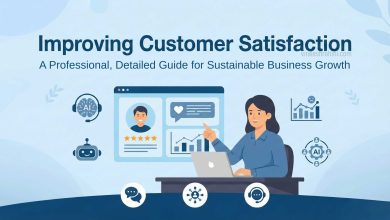What is VSO ? : Comprehensive Guide 2025
What is VSO : In today’s digital age, search engines are becoming smarter, and the way we interact with them is evolving. One of the most significant advancements in search technology is the rise of voice search. Voice Search Optimization (VSO) is a digital marketing strategy designed to improve the visibility of websites or content for voice search queries.
Table of Contents
As more people use voice-enabled devices like smartphones, smart speakers, and virtual assistants, businesses and content creators must adapt their strategies to optimize their content for voice search.
Understanding Voice Search

Voice search refers to the use of voice recognition technology to perform a search on a search engine by speaking rather than typing. Powered by artificial intelligence (AI), voice search systems like Google Assistant, Siri, Amazon Alexa, and Microsoft Cortana understand and process natural language queries. For instance, instead of typing “weather forecast today,” users can simply say, “What’s the weather like today?”
Also Read : How To Make Money as a Digital Marketer
This shift towards voice-driven search has been driven by the growing use of virtual assistants and devices such as smartphones, smart speakers, and IoT-enabled gadgets. As a result, voice search has changed how people search for information, often using conversational phrases, long-tail keywords, and question-based queries.
Why is VSO Important?
With the increasing use of voice search, optimizing for it has become crucial for businesses, content creators, and marketers who want to stay competitive. Studies show that over 55% of consumers use voice search to find local information, and this trend continues to rise. With voice search, users tend to ask more specific questions and expect more precise, direct answers.
As a result, websites and content need to be optimized in a way that aligns with the natural language used in voice searches. VSO aims to enhance user experience by ensuring that content is accessible, accurate, and easily understood by voice-enabled systems. Without VSO, businesses may miss out on valuable traffic and visibility from voice search users.
Key Aspects of Voice Search Optimization
- Natural Language Processing (NLP): Voice search optimization revolves around the concept of natural language processing (NLP), a technology that enables voice assistants to understand human speech in a way that mimics real-life conversations. As voice searches are often phrased in a more conversational tone, optimizing content to align with how people naturally speak is crucial. Businesses should focus on long-tail keywords and phrasing that closely resemble how users would ask questions.
- Question-Based Keywords: Voice searches tend to be more question-based than text-based queries. People typically ask questions like “What are the best restaurants near me?” or “How do I fix a leaky faucet?” As such, optimizing content with FAQs, clear answers, and question-based keywords is a key strategy in Voice Search Optimization. Incorporating phrases like “how,” “what,” “where,” and “why” into your content can help increase the chances of appearing in voice search results.
- Local SEO and “Near Me” Searches: Voice searches often include location-based queries, such as “Where can I buy a laptop near me?” or “Find a coffee shop near me.” Local SEO plays an important role in VSO, as voice search users frequently look for nearby services or products. Optimizing for local keywords, claiming and updating your Google My Business listing, and ensuring that your business information is accurate and consistent across the web are all key steps in boosting visibility for local voice search queries.
- Featured Snippets and Position Zero: When it comes to voice search, featured snippets, or position zero results, are highly coveted. Voice assistants often read aloud the information from featured snippets at the top of search engine result pages (SERPs). Optimizing content to appear as a featured snippet by answering questions clearly and concisely, with bullet points, numbered lists, or concise paragraphs, can increase the chances of being selected by voice search devices.
- Mobile and Page Speed Optimization: Since most voice searches are conducted on mobile devices, optimizing your website for mobile responsiveness and fast loading times is crucial. Slow-loading pages can result in higher bounce rates and lower rankings, negatively impacting visibility in voice search results. Page speed optimization techniques such as compressing images, enabling browser caching, and utilizing Content Delivery Networks (CDNs) can help enhance mobile user experience.
- Schema Markup: Implementing schema markup is a powerful way to help search engines understand your content better. By using structured data to provide additional context about your content, schema markup helps search engines deliver more accurate results. It can help in highlighting important information such as events, recipes, products, reviews, and more, which may be used by voice search assistants when delivering answers.
- Conversational Content: With the shift towards voice search, content should be optimized to match a more conversational tone. Voice search users tend to ask questions in a manner similar to how they would talk to a human. Therefore, content should be written in a more natural, engaging, and user-friendly style, making it easier for voice search systems to comprehend and return relevant answers.
- Voice Search Analytics: To optimize effectively, tracking how voice search impacts your website traffic and performance is essential. Monitoring keyword performance, user behavior, and traffic from voice-enabled devices can help you refine your VSO strategy. Google Analytics and other analytic tools provide insights into how users interact with your content and how well it ranks for voice search queries.
The Future of Voice Search Optimization

Voice search is expected to continue growing rapidly, as more people adopt smart speakers and voice-enabled devices. In fact, by 2024, it is estimated that half of all searches will be voice-based. As AI and natural language processing technologies evolve, voice search will become more sophisticated, allowing for even more accurate and context-driven responses. This makes it crucial for businesses and content creators to stay ahead of the curve by continuously adapting their strategies for voice search optimization.
Moreover, with the rise of multi-modal experiences, where users combine voice and visual search, the need to integrate voice search into the broader digital marketing strategy will become even more important. By ensuring that content is optimized for voice search, businesses can maintain their competitive edge in an increasingly voice-driven world.
What is VSO – Conclusion

Voice Search Optimization (VSO) is a critical aspect of modern digital marketing. With more consumers using voice assistants to perform searches, businesses must adjust their content strategies to ensure they are visible and accessible to voice search users.
Buy Now : SEO Mastery Detailed Course
By focusing on natural language, local SEO, question-based keywords, and other optimization techniques, businesses can enhance their online presence and effectively reach customers using voice search. With voice search continuing to evolve, VSO will remain an essential strategy for success in the digital marketing landscape.
Keywords : What is VSO – What is VSO 2025 , What is VSO and Applications



